What is a solar space power plant (SPS)? It will have to be located on the so-called geostationary orbit - a circular trajectory with a radius of about 35 thousand km. Turning around the Earth in 24 hours, the station rotates synchronously with the planet and as it hangs over a certain point of its surface. (These orbits are now being launched by the broadcast communication satellites - the well-known "Lightnings", "Screens", etc.). A station in such an orbit will be illuminated by the sun's rays more than 99% of the time. Each square meter of photovoltaic "wings" of the station will receive about 15 kW of power from the Sun. In principle, there is nothing difficult in building "wings" with an area of several tens of square kilometers and producing millions of kilowatts of electricity. According to one of the projects, a solar power station with two "wings" 5X6 km in size, each with a conversion factor of light to electricity - 0.1 will be able to produce 5 million kW - as much as today our largest hydroelectric power stations.
A schematic diagram of this type of SPS is shown below:
Specialists expect that space SES will be able to generate up to 100 mW of electricity. The advantage of this technology is that, unlike terrestrial solar power plants, where their effectiveness is affected by time of day and weather, space analogs will have a constant source of energy. According to various estimates, solar panels in space can produce 8-10 times more electricity than photocells located on the surface of the planet.
There is another project, according to which, instead of photovoltaic cells in space, giant mirrors are collected from individual modules. With their power, you can focus the sun's rays from a large area on a powerful steam boiler. And further on, the usual scheme: the resulting superheated steam rotates the turbine, which, in turn, sets in motion an electric generator.
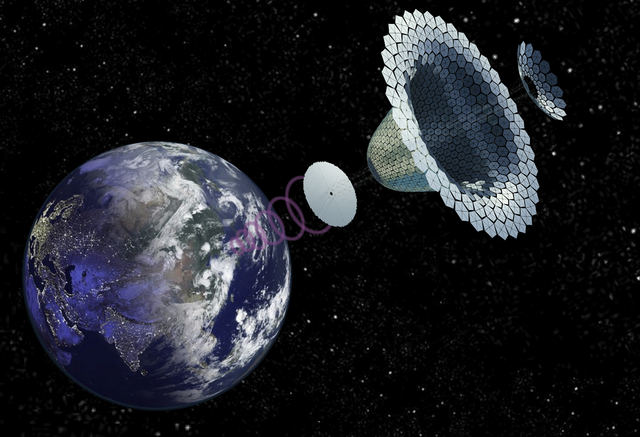
source
The concept of SPS with focusing mirrors and modules is shown in Fig. 2.48.
The mass of the equipment of the SPS power of 10 million kW on photovoltaic batteries will be about 35 thousand tons, and stations with turbo generators - more than 100 thousand tons. How to throw such a machine into space? It is clear that the assembly of the SPS is best carried out in near-earth orbit in parts, using for their delivery automatic transport ships, whose prototypes - "Progresses" have become a familiar attribute of our space expeditions. When the station is assembled, it is slowly and carefully - with the help of rocket engines - to not create large overloads and damage the structures - will be transferred to a geostationary orbit.
Let's assume that all the problems associated with the construction of SPS and the generation of electricity on it have been resolved. The station generates billions of kilowatt-hours of electricity, but what to do with it? Energy is waiting for consumers on Earth, but how to transfer it there, not by wires?
Today a number of scientific teams in our country and abroad are dealing with problems of wireless power transmission over long distances. In principle, there are two ways to do this: using a laser beam or using microwave radiation (microwave). The most advanced method for today is the second method, which promises huge benefits: electricity can be pumped through waveguides, pipes like oil and gas pipelines laid underground.
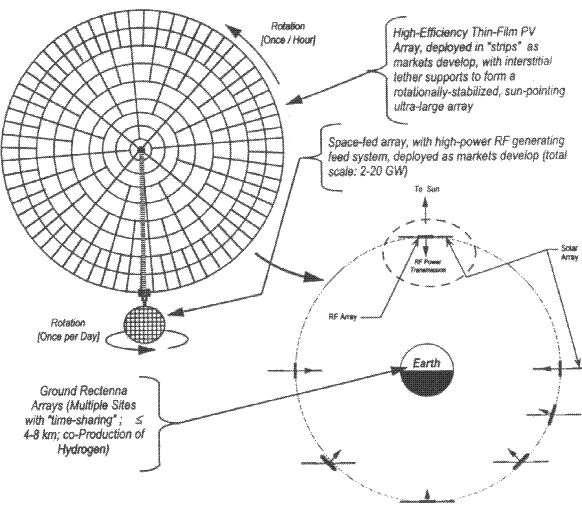
source
Under the conditions of cosmic vacuum, the energy in the microwave beam will propagate practically without scattering and loss. And in the atmosphere, under the action of microwave radiation, a narrow channel appears, formed by ionized gas molecules. Through this channel, energy in the form of electromagnetic radiation will be transmitted unobstructed tens of thousands of kilometers from SCNP to consumers on Earth. On its surface a bowl of a receiving antenna with a diameter of several kilometers will receive microwave radiation, which will then be converted into a conventional alternating or direct current and will enter the electric network.
However, life can make significant adjustments to this project. Increasingly in terrestrial conditions, wishing to limit the length of high-voltage power lines and reduce the loss of electricity costs for construction, unproductive alienation of land, we are striving to bring energy-intensive industries closer to energy sources.
Pros and cons of the NPP
In principle, microwave beams are dangerous for people traveling by air. In theory, the airplane body must protect, shield the crew and passengers from the harmful effects of rays. But will not there be any disruptions in the operation of the on-board electronics, fatal for the aircraft? It is possible that some zones will have to be forbidden for air transport.
The most careful study requires the problem of placing ground receiving antennas and their influence on the environment. The area of the receiving antenna is about 250 km². To take it out of its useful use is an impermissible luxury in our time. But experts argue that the antenna array can be raised above the surface and use the territory for agricultural land - arable land, orchards, pastures. After all, the grate absorbs radiation almost completely, skipping sunlight and precipitation. In extreme cases, you can place receiving antennas on the sea or uninhabited islands.
As for emissions of harmful waste into the atmosphere - what suffer from thermal power plants, in this respect solar power plants are impeccable.
True, there is one serious danger. It, however, can become an obstacle on the way not only of the SCNP, but also of mass cosmic expansion in general. Modern rocket engines operating on chemical fuel emit a large amount of nitrogen oxides into the atmosphere. Accumulating in the areas of space routes, they will affect the composition and properties of the upper layers of the atmosphere. In particular, nitrogen oxides contribute to the breakdown of ozone molecules, which, in the final analysis, can lead to the destruction of the ozone belt - a kind of shield that covers all life on the planet from the harmful effect of the hard ultraviolet radiation of the Sun. Meanwhile, the construction and operation of SPS and other space industry facilities will require the creation of a powerful space fleet that could provide regular delivery of large consignments of goods. How to behave ozone belt under such a huge load, it is difficult to say.
Such are the pros and cons of solar space energy. However, such a picture is typical for the whole energy industry. We do not know now any source of energy that would have only merits and was free from shortcomings. The economy and ecology dictate to the energy industry their strict requirements, and they can not be ignored.
In the field of design and the proposed construction of SPS, it is possible to mention such countries as the USA, Russia and Japan. If in Russia the SESP project is suspended, then in the US and Japan it continues to develop.
For example, the California Public Utilities Commission approved an agreement to purchase 200 megawatts of electricity from the company's Pacific Gas and Electric Company from 2016 on Solaren's solar power plant. Solaren is designing a satellite - a solar power plant. On the surface of the planet, the energy will be transmitted in the form of a beam of radio waves in the microwave range to a special receiving station . The flux of solar energy in a geosynchronous orbit is almost continuous. Ground-based solar power plants operate only in the daytime and in clear weather.
Solar-powered space-based power plants have been a dream for several decades in both the US and Japan. Despite the fact that the high cost of their creation was a deterrent, nevertheless, now Japan has a new understanding of this issue. A national space plan has been developed calling for a program of "world leadership in the field of solar space-based energy". At the University of Kyoto, a meeting of politicians, engineers and scientists on this issue was held.

steemSTEM
Want to discover more science and technology related content on Steemit? Follow @steemSTEM to see a weekly selection of quality science posts, as well as STEM-related contests. Are you interested in writing posts on related topics yourself? Make sure to join the steemSTEM channel on steemit.chat to engage with other scientists on steemit!


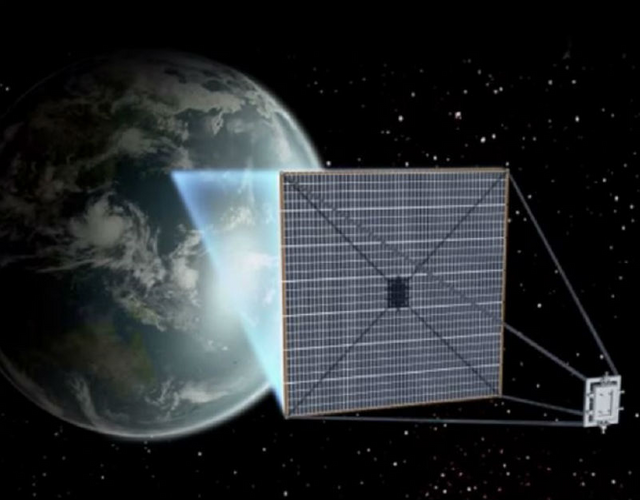
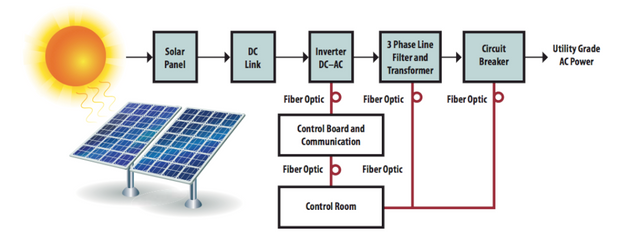
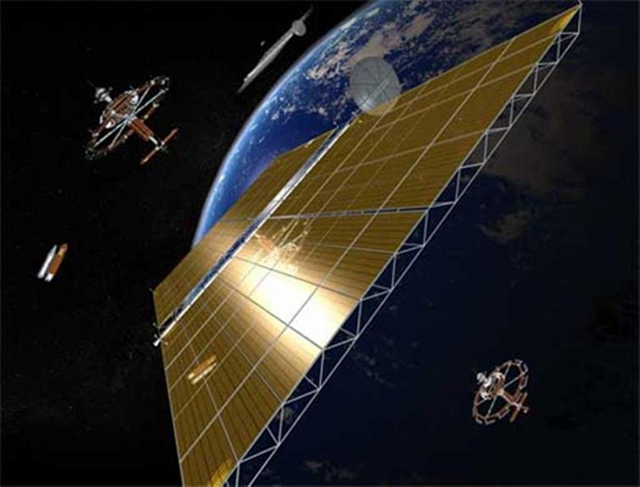
This post has received a 0.61 % upvote from thanks to: @amity123.
thanks to: @amity123.
For more information, click here!!!!
Send minimum 0.100 SBD to bid for votes.
Before sending a transfer to @minnowhelper, verify that your publication meets these conditions (http://www.minnowhelper.com/conditions.php). After the transfer is made, no claims will be received.
The Minnowhelper team is still looking for investors (Minimum 10 SP), if you are interested in this, read the conditions of how to invest click here!!!
ROI Calculator for Investors click here!!!
Downvoting a post can decrease pending rewards and make it less visible. Common reasons:
Submit
Congratulations! This post has been awarded a 100% upvote by @lottobot! This post was the winner of lottery #1208, which had a total of 5 entries. @lottobot always has a lottery going on! If you would like to nominate a post for the current lottery, just send 0.1 SBD or STEEM to @lottobot, and include the url of the post you would like to nominate as a memo. Learn more by reading the introductory post! Good luck!
Downvoting a post can decrease pending rewards and make it less visible. Common reasons:
Submit
A brilliantly detailed piece. I'm not sure I understood it all but it would seem that the future will bring new and exciting ways of harnessing the energy from the sun
Downvoting a post can decrease pending rewards and make it less visible. Common reasons:
Submit
Wow, this post is amazing, who would have thought that solar power could be taken even further....it this project works, it will change the world!!! wow!
Downvoting a post can decrease pending rewards and make it less visible. Common reasons:
Submit
You have collected your daily Power Up! This post received an upvote worth of 2.62$.

Learn how to Power Up Smart here!
Downvoting a post can decrease pending rewards and make it less visible. Common reasons:
Submit
Technology has further improve. We will one day make the world a better place. You can read my article on how to solve world energy problem here: https://steemit.com/ico/@simplibaba/bittwatt-solution-on-energy-supply-biling-and-balancing and kindly leave some reviews
Downvoting a post can decrease pending rewards and make it less visible. Common reasons:
Submit